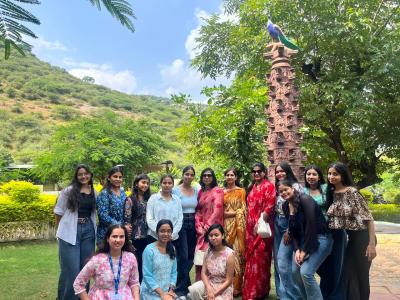Visit to Khazana mahal

Visit– A Report
A visit to Khazana Mahal Museum Jaipur
Name of the Department : Jewellery Designing
Date : 20th September 2025, Saturday
Time : 10:30 A.M to 2.45p.m.
Venue : Khazana Mahal, Amer, Jaipur.
No. of Students : 13
Objectives
- To see first-hand rare and exquisite collections of gems, ornaments, and jewellery design heritage.
- To understand materials, craftsmanship techniques, motif development, historical influences, and preservation.
- To draw inspiration for contemporary jewellery design from traditional and artistic exhibits.
- To appreciate the interplay of culture, architecture, and decorative arts in jewellery aesthetics
Introduction
The Department of Jewellery Designing organised an educational visit to Khazana Mahal, Jaipur, on 20th September 2025 for the students of B.Sc., and M.A./M.Sc., Jewellery Design courses. The aim of the visit was to provide students with hands-on exposure to India’s jewellery heritage, unique craftsmanship techniques, and the cultural contexts that inspire traditional and modern design.
Khazana Mahal, known as a Museum of Gems & Jewellery, houses rare artefacts and replicas that showcase India’s rich ornamentation traditions. Its highlights include the World’s Biggest Finger Ring, a replica of the Koh-i-Noor Diamond, and the Miss Universe Crown, each offering valuable lessons in proportion, symmetry, and gemstone setting. The Infinity Room / Sheesh Mahal with intricate mirror work illustrated how architecture and decorative arts inspire jewellery aesthetics. Alongside jewellery, the museum integrates cultural experiences such as folk performances, puppet shows, and bird habitats, creating a holistic environment that connects heritage, art, and design.
During the guided tour, students closely observed large-scale artefacts to understand scale and craftsmanship, studied gemstone variety to deepen knowledge of cuts and colour harmony, and explored Rajasthani motifs of flora, fauna, and geometry for design inspiration. The Miss Universe Crown demonstrated techniques of balance and ornamentation, while the Sheesh Mahal’s reflective mirror work encouraged ideas for surface decoration and light play in jewellery. These experiences allowed students to see how traditional artistry can be adapted into innovative, contemporary design practices.
The educational trip to Khazana Mahal proved to be both enriching and inspiring for the jewellery designing students. It not only deepened their appreciation for India’s jewellery traditions but also encouraged them to think creatively about integrating heritage techniques into contemporary practice. The visit highlighted the importance of linking cultural context, architectural motifs, and decorative arts with jewellery design. Overall, it was a valuable experience that will contribute meaningfully to the students’ academic learning and future professional practice
Outcomes
The visit provided students with:
- A clearer understanding of how heritage jewellery and artefacts influence modern design practices.
- Inspiration to incorporate Rajasthani motifs, mirror work, and gemstone combinations into innovative designs.
- Insights into presentation and exhibition—highlighting the importance of lighting, storytelling, and display context in jewellery appreciation.
- A chance to bridge classroom theory with real-world observation, reinforcing technical knowledge of materials, cuts, and finishes

